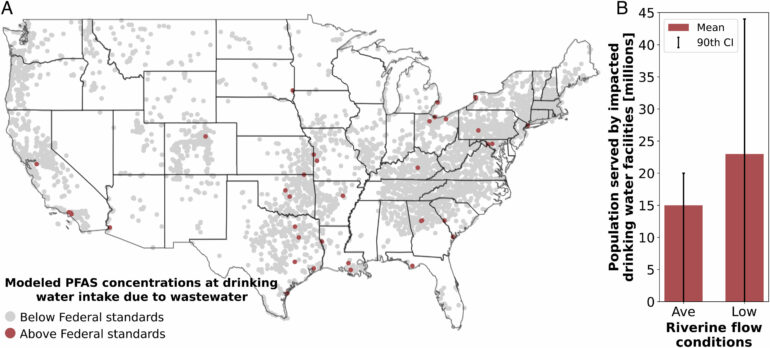The “forever chemicals” flowing from U.S. wastewater treatment plants are not only more abundant than previously thought, but also largely consist of pharmaceuticals that have received little scientific or regulatory attention, a new multi-university study reveals.
The research, published in Proceedings of the National Academy of Sciences, found that common prescription drugs make up about 75% of the organic fluorine in wastewater entering treatment plants, and 62% in treated water released to the environment.
These findings suggest millions of Americans could be exposed to these persistent chemicals through their drinking water.
“We’ve been focused on a small subset of these chemicals, but that’s just the tip of the iceberg,” said Bridger J. Ruyle, an incoming Assistant Professor in NYU Tandon School of Engineering’s Civil and Urban Engineering department and the study’s lead author. “The research shows that even advanced wastewater treatment removes less than 25% of these compounds before they’re discharged into rivers and streams.”
Of particular concern is that six forever chemicals recently regulated by the Environmental Protection Agency in drinking water make up only about 8% of the organic fluorine found in wastewater effluent. The remainder consists largely of fluorinated pharmaceuticals and other compounds that aren’t currently regulated.
Using a national model that tracks how wastewater moves through U.S. waterways, the researchers estimate that during normal river conditions, about 15 million Americans receive drinking water containing levels of these compounds above regulatory limits. During drought conditions, that number could rise to 23 million people.
The study examined eight large wastewater treatment facilities serving metropolitan areas across the United States. These facilities are similar to those serving about 70% of the U.S. population, suggesting the findings have broad national implications.
“What’s particularly troubling is that these fluorinated pharmaceuticals are designed to be biologically active at very low doses,” said Ruyle. “We don’t yet understand the public health implications of long-term exposure to these compounds through drinking water.”
The research comes at a critical time, as about 20% of all pharmaceuticals now contain fluorine. While this chemical element makes drugs more effective by helping them persist in the body longer, that same persistence means they don’t break down in the environment.
The findings suggest that current regulatory approaches focusing on individual chemicals may be insufficient to address the complex mixture of fluorinated compounds in wastewater. The study also highlights how water scarcity could exacerbate the problem. In regions experiencing drought or implementing water conservation measures through wastewater reuse, there’s less dilution of these chemicals before they reach drinking water intakes.
“These results emphasize the urgent need to reduce ongoing sources of these chemicals and evaluate the long-term effects of fluorinated pharmaceuticals in our water supply,” said Ruyle.
“We can’t just focus on the handful of compounds we’ve studied extensively while ignoring the majority of what’s actually out there. We need a more comprehensive approach to regulation and increased attention to the ecological and public health impacts of fluorinated pharmaceuticals.”
The paper’s publication comes on the heels of Ruyle’s November 2024 testimony to New York State lawmakers warning about the threats of forever chemicals passing through water treatment plants. The new findings provide detailed evidence supporting his concerns about the potential prevalence of these compounds in downstream drinking water supplies.
More information:
Bridger J. Ruyle et al, High organofluorine concentrations in municipal wastewater affect downstream drinking water supplies for millions of Americans, Proceedings of the National Academy of Sciences (2025). DOI: 10.1073/pnas.2417156122
Provided by
NYU Tandon School of Engineering
Citation:
‘Forever chemicals’ in wastewater far more widespread than previously known, study reveals (2025, January 7)



